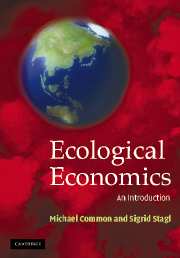Book contents
- Frontmatter
- Contents
- List of figures
- List of tables
- List of boxes
- Preface
- Introduction
- Chapter 1 An introduction to ecological economics
- PART I INTERDEPENDENT SYSTEMS
- Chapter 2 The environment
- Chapter 3 Humans in the environment – some history
- Chapter 4 The economy in the environment – a conceptual framework
- PART II ECONOMIC ACTIVITY
- PART III GOVERNANCE
- PART IV THE INTERNATIONAL DIMENSION
- References
- Index
Chapter 4 - The economy in the environment – a conceptual framework
Published online by Cambridge University Press: 05 June 2012
- Frontmatter
- Contents
- List of figures
- List of tables
- List of boxes
- Preface
- Introduction
- Chapter 1 An introduction to ecological economics
- PART I INTERDEPENDENT SYSTEMS
- Chapter 2 The environment
- Chapter 3 Humans in the environment – some history
- Chapter 4 The economy in the environment – a conceptual framework
- PART II ECONOMIC ACTIVITY
- PART III GOVERNANCE
- PART IV THE INTERNATIONAL DIMENSION
- References
- Index
Summary
In this chapter you will:
Learn about the ways in which the economy and the environment are interdependent;
Find out how natural resources can be classified;
Look at waste flows and pollution;
Learn how the use of natural resources and waste generation are related;
Consider the amenities and life support services that the environment provides;
See how the functions that the environment performs for the economy interact with one another, and may be competitive;
Look at threats to sustainability that originate in economy–environment interdependence.
The purpose of this chapter is to look at the economic system in relation to the environment system that supports it. It concentrates on the big picture and on setting out the conceptual framework that will be used throughout the book. The perspective from which the framework is developed is that of a modern industrial economy. A supplement to this chapter, which fleshes out the conceptual framework with information and data, will be found on the website that goes with the book. You will also find on that website lots of links to other sites that give similar and related information and data.
The first section of the chapter briefly sets out the whole big picture of economy–environment interdependence, and subsequent sections are mainly about looking at parts of the picture. The final section considers threats to sustainability that have their origins in the relations between economic activity and the natural environment.
- Type
- Chapter
- Information
- Ecological EconomicsAn Introduction, pp. 86 - 122Publisher: Cambridge University PressPrint publication year: 2005



